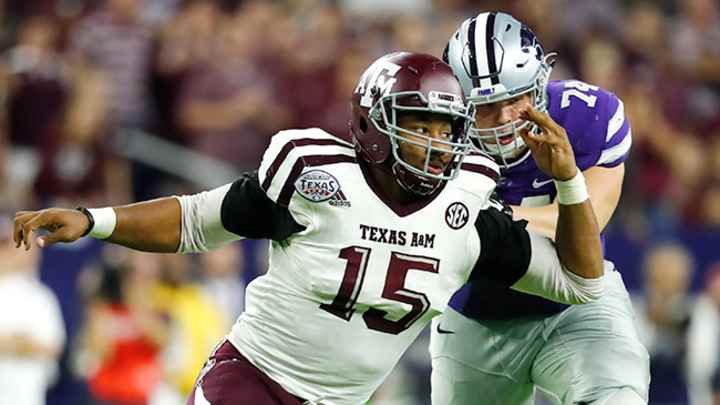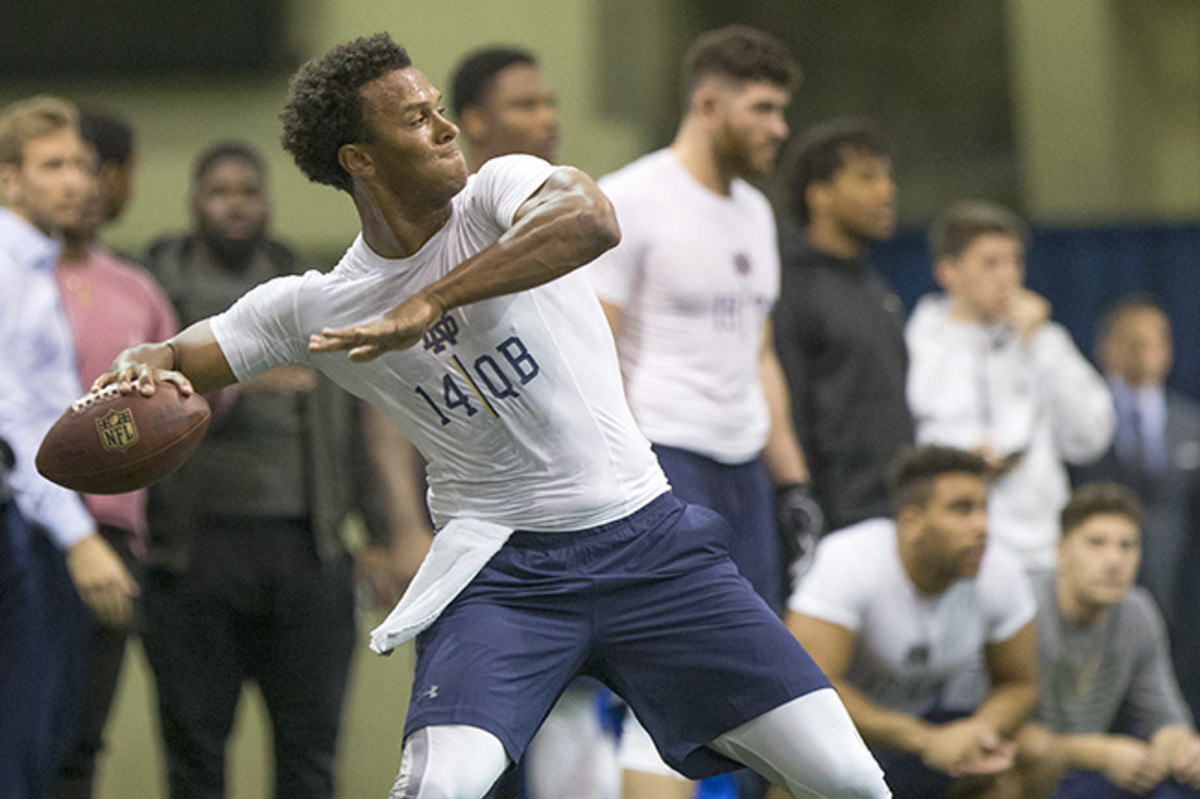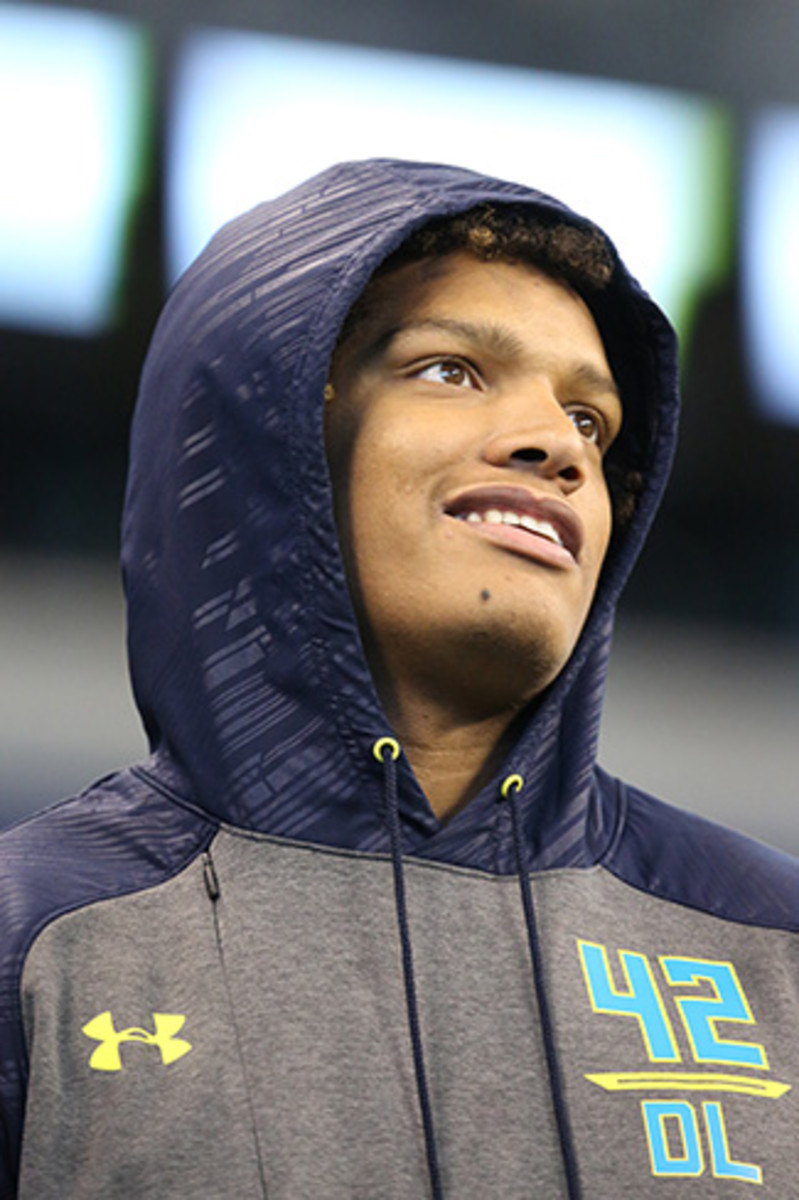On Myles Garrett, Competitor

COLLEGE STATION, Texas — Last week marked the busiest bunch of pro days this month, as NFL evaluators were dispatched to Ann Arbor, Berkeley, Chapel Hill, Columbus, Los Angeles, Palo Alto and South Bend—some making two, even three stops in a three-day span. We’ll hit highlights from each of those sessions, through the eyes of scouts who were on the ground, but we begin this column in College Station.
Texas A&M holds its pro day on Wednesday, the final public exhibition for presumed No. 1 overall pick Myles Garrett. The Browns may not send much of a contingent; they’ve already conducted a private workout with the defensive end.
We witnessed Garrett’s freakish size/speed/athleticism combination at the combine. As reported by colleague Robert Klemko, one defensive coordinator summarized: “I don’t have a player comparison for what I just saw. He looked like Wolverine.”
On film, Garrett’s explosiveness led to dozens of pressures; he had a knack for diagnosing plays and bursting into the backfield. He steadily improved against the run. He recorded 32.5 sacks in three seasons, despite battling an ankle injury in 2016. His ceiling feels limitless once Garrett refines a few pass rush moves.
Yet something has nagged me about the way Garrett’s college career is discussed. In his NFL.com profile, there’s a line under weaknesses: “Scouts are convinced he took plays off to protect his health this season.” When a reporter asked Garrett about such criticisms at the combine, he shrugged it off. “Nobody is 100 percent every play,” Garrett said. “You know, eight, nine plays down the drive. Sometimes you do look back at it and say, ‘Dang, I could have gave more effort there or I loafed it a little.’ But you work on those things.”
When NFL evaluators visited College Station over the past three years, they have asked: What type of competitor is Garrett? The answers, and examples, are emphatic.
* * *

Last week, I spent time with Texas A&M offensive lineman Jermaine Eluemunor (for a longer project, which I’m excited to share soon). He joked: “I credit Myles for me redshirting my first year here. He just dogged me in that first practice. Picked me up and threw me.” Eluemunor detailed how his star teammate became his practice adversary. Of course, coaches knew what kind of athlete Garrett was when he walked on campus. He was 18 years old and had what teammates describe as an eight pack. He’s a once-in-a-generational type talent. “But we’d get after it at practice,” Eluemunor says. “He’d fight, but fight with a smile on his face. Because he loved it.”
I asked A&M coach Kevin Sumlin about Garrett as a competitor. “People take for granted his injury status,” Sumlin says. “A lot of guys would have just shut it down and just not played.” Sumlin pointed to one game: an Oct. 28, double-overtime battle between then-No. 8 Texas A&M and then-No. 9 Tennessee at Kyle Field. Garrett had missed the previous week’s game with a leg injury.
“He probably shouldn’t have played against Tennessee,” Sumlin says. “He wasn’t going to miss that game for anything. We started off with, O.K., he’ll just play third downs and rush the passer, and that was the plan because we had a whole season to go. And you look up, and it’s overtime, and I go, ‘What are you doing?’ And he goes, ‘I’m not coming out.’ So he played both overtimes.”
Sumlin continued: “That speaks to a couple things. He loves the game. As great of an athlete as he is, he’s an even better competitor and even better teammate. He wasn’t 100 percent, he was still very effective, and that said a lot to his teammates who he is, that said a lot to our fans, but I think it also said a lot to GMs and people at the next level that he was really hurt. But to play and not shut it down and say, ‘Hey, I can just wait for the draft,’ says a lot about what type of player he is. What people saw on Saturday was just a snapshot of what went on during the week, during camp, during Myles’ time here.”
NFL evaluators, especially the Browns, seem to understand that. It’s why more likely than not, Garrett will hear his name called first on April 27.
•THE COLLEGE COLUMN ON THE QBS: Mitch Trubisky | Deshaun Watson | DeShone Kizer | Patrick Mahomes | Davis Webb | Nathan Peterman | Chad Kelly
* * *

Here’s one thing we learned at each stop during a packed week of pro days…
1. In South Bend, DeShone Kizer rebounded from a so-so combine performance. While a lot was said about the hodgepodge group of receivers Kizer threw to (including ND alum and former Patriots running back Jonas Gray) evaluators seemed impressed by strides the Notre Dame quarterback made, particularly his more consistent footwork.
2. At Michigan, Jabrill Peppers remains one of the most perplexing evaluations in this year’s class. Peppers said most teams view him as safety—according to Peppers’ breakdown, 30 teams have said they want him at safety, one said linebacker and one said offense—there are still hesitations because he has limited tape at the position and he only has one career interception. Peppers did position drills with safeties and defensive backs in Ann Arbor.
3. Ohio State cornerback Marshon Lattimore, who has battled hamstring injures throughout his career, downplayed the injury that cut his combine short (he says it was a tight hip flexor after running the 40, and shut it down as a precaution). Lattimore looked excellent in the short period of position drills and appears destined for the Top 10.
4. With a school record for scouts in attendance in Chapel Hill, Mitchell Trubisky completed a 68-pass throwing session, scripted by his draft quarterback coach Ryan Lindley. According to one scout in attendance, Trubisky looked “crisp” with “no real areas for concern.”
5. Christian McCaffrey put on a show at Stanford by working out as a wide receiver and catching kickoffs from a jugs machine. It was a strategic move as the running back reminds teams that his versatility adds immense value.
6. USC cornerback Adoree’ Jackson could be a darkhorse first-round candidate because of his Day 1 impact as a punt returner. To test his ball skills, one team asked Jackson to field a punt while already holding three balls—a task he fulfilled seamlessly.
7. Cal’s pro day was marred by heavy rain, but what was most notable after Davis Webb’s throwing session was his continued, immense confidence. The quarterback told reporters “double-digit teams” have told him he’s a first round talent. “Every meeting I’ve had, they’ve said I’m probably the best quarterback on the board they’ve seen,” Webb said, according to Cam Inman of the Mercury News.
* * *
FIVE THINGS YOU NEED TO KNOW
1. Sidney Jones says he will be ready to play in 2017. In an interview with USA Today’s Tom Pelissero, the Washington cornerback pledged he will not miss anytime after surgery last week to repair a ruptured Achilles tendon. Said Jones: “The doctor told me I should be right on schedule to play at the beginning of the season.” The article also quotes Jones’ orthopedic surgeon, Robert Anderson, who “stressed while it’s impossible to predict a timeline for a player’s return to peak effectiveness” he anticipates Jones to “have the potential to be back on the field this year.” Perhaps the top cover corner in this year’s draft, Jones fell while backpedaling on the final drill of Washington’s pro day. The average return-to-play time from such surgery is six months: That’s September for Jones. Though Jones remains confident, it seems likely the injury pushed him to at least the bottom of the first round. (If he falls out of the first, Jones can cash in on a loss-of-value insurance policy.)
2. Jones wasn’t the only cornerback to sustain a serious injury during his pro day. UCLA’s Fabian Moreau tore a pectoral muscle while bench pressing. Moreau also underwent surgery. The 6-foot, 208-pound corner had an outside chance at the first round. He impressed scouts at the combine with a 4.35 40-yard dash and 11-foot, 4-inch broad jump, reinforcing what many evaluators saw on film: He is an explosive athlete with tremendous upside. Moreau played running back and wide receiver through high school. However, this is now the second significant injury for Moreau, who also sustained a season-ending Lisfranc fracture in his left foot in 2015. In a year with a dozen top-end cornerback prospects, Moreau’s injury history will push him to at least the second round.
3. We are reaching the homestretch of pro days. On Tuesday in Florida, lots of attention will be paid to a pair of cornerback prospects, Teez Tabor and Quincy Wilson. Tabor didn’t have the best combine, including a mediocre 4.62 forty, so he needs a strong pro day to re-enter the Round 1 conversation. Wilson is a physical corner who doesn’t lack confidence (he reads mock drafts, just like the rest of us, and has no problem calling out prognosticators who leave him out of Round 1). But perhaps more important in Gainesville will be the performance of Jarrad Davis. The linebacker did not do combine workouts while still recovering from a high ankle sprain. He’s a high-effort playmaker hovering around the Round 1 fringe. Dalvin Cook headlines Florida State on Tuesday, but offensive tackle Roderick Johnson will get plenty of looks, as will defensive end DeMarcus Walker. On Thursday, it’s Texas A&M, aka Myles Garrett-fest. Even though Garrett crushed his combine testing, he apparently wasn’t happy with his 40 and could run it again. Josh Reynolds, a late bloomer and JuCo transfer, is one of my favorite wideouts in this year’s class out side of the Big 3. And look out for College Column alum Jermaine Eluemunor. His stock is trending way up and I’m told a few teams now have second-round grades on the offensive lineman. And on Friday, I’ll be in Lubbock, Texas (taking all food recommendations if you’ve got them!) where Patrick Mahomes will be the last of the top quarterback prospects to preform on a pro day.
4. Oh no, has yet another tight end entered the mix? You’re probably sick of hearing about this crowded class of tight ends, but it’s hard to understate just how impressive a year it is. I’ve heard another name being circulated as a Top 5 prospect at the position—and in 2017 that likely means second round: Ashland’s Adam Shaheen. The Division II former walk-on (and basketball transfer from Division II Pittsburgh-Johnstown) made for a cutesy story at the combine when he shared that he gained nearly 80 pounds in college by gorging on Chipotle burritos. His 6' 6" frame filled out to 278 pounds, and now he’s getting on-field comparisons to Rob Gronkowski. After an impressive combine, 16 team reps trekked to Ashland, Ohio last week for his pro day, and he’ll have a handful of private workouts over the next month.
5. The Chargers and Saints are among the teams to put Patrick Mahomes through a private workout. The Chiefs have scheduled a date with Mitchell Trubisky. There are plenty more sessions planned between the top crop of quarterbacks and teams with entrenched starters. The consensus is that 2017 is not actually a bad draft class, as long as you’re not in dire need of a rookie to play in 2017. A month before the draft, it’s fair to wonder who will dominate the first-round quarterback market: quarterback-needy teams or franchises like the Chargers, Chiefs and Saints looking for options for 2018, ’19 and beyond?
* * *
GET TO KNOW A PROSPECT
A quick Q&A with a prospect generating buzz. This week: Notre Dame defensive lineman Isaac Rochell. A three-year starter and senior team captain for the Fighting Irish, Rochell’s college career was littered with peaks and valleys. (At the combine, almost every team asked him: “Why did Notre Dame go 4-8 last year?”) However, NFL teams want to look forward. And in Rochell they get a classic tweener. At 6' 4", 280 pounds, Rochell saddles between defensive end and tackle. He’s played both positions, potentially offering flexibility to NFL defensive coordinators, though evaluators say he’ll need to be more disruptive in getting after the quarterback if he wants to make it in the NFL…

Tell me about your experience level at both positions
My freshman year we were a 3-4 defense, a very true 3-4. Then Brian VanGorder came on and we switched to a 4-3 with some 3-4 elements. It was difficult to switch. The hardest part was, you need to play with a different mentality in each scheme. It took all spring my sophomore year to understand it—coming off the ball and really playing with the penetration mindset. But what will benefit me moving forward is that I’ve played in multiple defenses so I’m familiar with a bunch of different fronts. I also have shown I can learn a defense. At Notre Dame I had three different defensive coordinators and had to learn three different packages.
How did you start playing football?
I grew up in McDonough, Georgia, a small suburban town outside of Atlanta. I always grew up playing basketball. When I switched schools, the football coach harped on the idea that basketball players were soft. I was like, I’m not soft, I’m not going to take that label. So I took up football. As I realized I was good at football, I also fell in love with the game.
Any hobbies?
I’ve recently gotten into photography. I’m in Arizona training for the draft, and there are two hours a day when I can kind of do whatever. I didn’t want to just sit in my apartment and do whatever. I ended up buying a used camera and going to random really cool places in Scottsdale and taking pictures. Then I was like, Damn, these pictures are actually kind of good. So I started a little Instagram out of it. The coolest thing about photography is when you have a camera, it makes you want to go do stuff, explore and be creative.
When you hear “tweener” what do you think of?
It’s not a word that scares me. I know it can be a bad thing, but in my case I think it can be good. I’m kind of stuck in between two positions. It can be a negative thing if you’re caught in between and you weren’t necessarily able to produce at either position. But I can play both positions well and that means I have value.
* * *
MAILBAG!
I’ll be fielding questions every week between now and the draft. If you’d like to send a question to The College Column for next week’s mailbag, tweet @emilymkaplan or email talkback@themmqb.com.
@whudson712: Why do teams not draft like-minded backup QBs? Why Derek Anderson in Carolina and not someone like Evans from VT (big & mobile, etc)?
Excellent question. Newton’s case is specific because his skillset is so unique. The belief is: Should Carolina need a backup on short notice, the Panthers might not run the typical Newton quarterback draws or rollouts, because an inexperienced backup—even if he has some of the same traits as Newton—might get injured. And it’s probably not that hard for the rest of the offense, on short notice, to transition from a mobile quarterback to a drop back passer (in fact, it might be a relief for some offensive linemen). More generally on this topic: scouting quarterbacks is a fickle business. No matter when you draft a quarterback, there’s always a hope he can be the starter one day (or, second-best scenario: be valuable trade bait). Therefore teams usually prefer drafting the best talent available rather than reach for a lesser version of the quarterback that they already have.
@TimV1311: Hi Emily, CBs are deep in the draft. Lattimore out of the top 10 because of it or do you expect teams to stick to BPA?
No doubt it’s a great year if you need a cornerback. The thing is, most teams in the Top 10 could use a starter. And while you certainly could get a value pick in the second, third or even fourth rounds, Lattimore—with his incredible athleticism, instincts and propensity for hard hitting—sure looks like the real deal. He would instantly upgrade the secondary for the Bears, Titans, Jets and Bills, all teams picking within the Top 10. I’d be surprised to see him make it past there. Why? Because lurking at No. 11 (Saints), No. 12 (Browns), No. 13 (Cardinals) and No. 14 (Eagles) are four teams who really, really could use a player like Lattimore. The market might be loaded, but the demand is plenty high for a premium position.
@JEditoija How do you see Joe Mixon’s situation now? Have had many visits and knowing the talent is high, which round will he be taken?
I think Mixon’s status—pro day complete, case pleaded to interested teams—remains static. There are still at least two teams I know of that have removed Mixon’s name from their draft board completely. But many teams have done extensive background on him, and have interviewed him either in Oklahoma or at individual visits. It seems those teams feel increasingly comfortable drafting Mixon, which creates a market. Gut feeling: Mixon goes somewhere between rounds two and four.
Question or comment? Email us at talkback@themmqb.com.
